Sony GDM-5502 User Manual

4-206-664-01(1)
Color Graphic Display
21 inch model
Operating Instructions |
|
|
|
GB |
|||
|
|
|
|
||||
|
|
|
|
|
|
|
|
Mode d’emploi |
|
|
|
|
|
|
FR |
|
|
|
|
|
|
||
|
|
|
|
|
|||
Bedienungsanleitung |
|
|
|
|
DE |
||
|
|
|
|
||||
|
|
|
|
||||
Manual de instrucciones |
|
|
ES |
||||
|
|
|
|||||
|
|
|
|
||||
Istruzioni per l’uso |
|
|
|
|
|
IT |
|
|
|
|
|||||
|
|
|
|||||
Инструкция по эксплуатации |
|
RU |
|||||
|
|
||||||
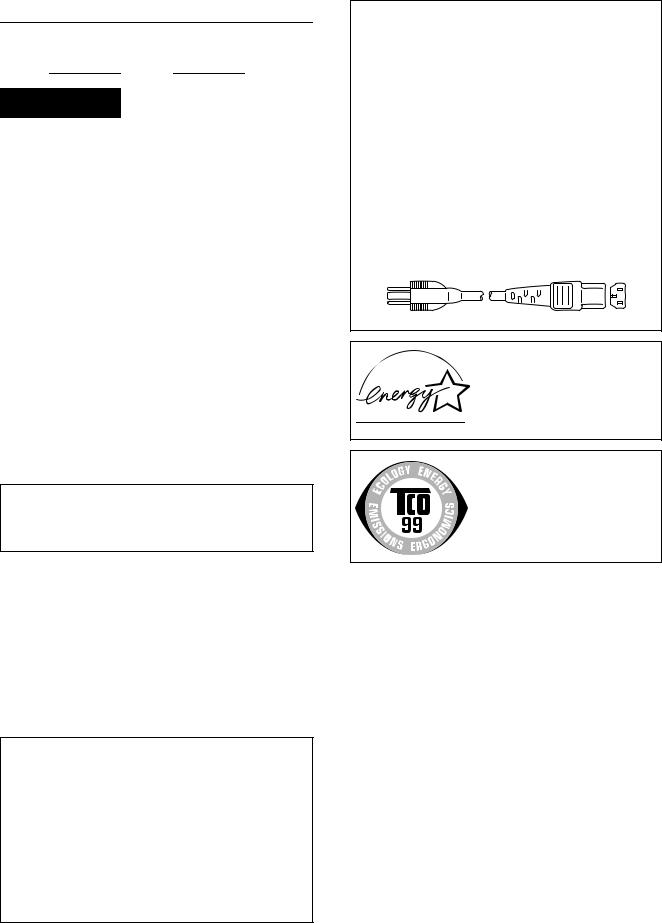
Owner’s Record
The model and serial numbers are located at the rear of the unit. Record these numbers in the spaces provided below. Refer to them whenever you call upon your dealer regarding this product. Model No. Serial No.
WARNING
To prevent fire or shock hazard, do not expose the unit to rain or moisture.
Dangerously high voltages are present inside the unit. Do not open the cabinet. Refer servicing to qualified personnel only.
FCC Notice
This equipment has been tested and found to comply with the limits for a Class B digital device, pursuant to Part 15 of the FCC Rules. These limits are designed to provide reasonable protection against harmful interference in a residential installation. This equipment generates, uses, and can radiate radio frequency energy and, if not installed and used in accordance with the instructions, may cause harmful interference to radio communications. However, there is no guarantee that interference will not occur in a particular installation. If this equipment does cause harmful interference to radio or television reception, which can be determined by turning the equipment off and on, the user is encouraged to try to correct the interference by one or more of the following measures:
–Reorient or relocate the receiving antenna.
–Increase the separation between the equipment and receiver.
–Connect the equipment into an outlet on a circuit different from that to which the receiver is connected.
–Consult the dealer or an experienced radio/TV technician for help. You are cautioned that any changes or modifications not expressly approved in this manual could void your authority to operate this equipment.
IMPORTANTE
Para prevenir cualquier mal funcionamiento y evitar daños, por favor, lea detalladamente este manual de instrucciones antes de conectar y operar este equipo.
INFORMATION
This product complies with Swedish National Council for Metrology (MPR) standards issued in December 1990 (MPR II) for very low frequency (VLF) and extremely low frequency (ELF).
INFORMATION
Ce produit est conforme aux normes du Swedish National Council for Metrology de décembre 1990 (MPR II) en ce qui concerne les fréquences très basses (VLF) et extrêmement basses (ELF).
INFORMACIÓN
Este producto cumple las normas del Consejo Nacional Sueco para MetrologÍa (MPR) emitidas en diciembre de 1990 (MPR II) para frecuencias muy bajas (VLF) y frecuencias extremadamente bajas (ELF).
Declaration of Conformity
Trade Name: |
SONY |
Model No.: |
GDM-5502 |
Responsible Party: Sony Electronics Inc. |
|
Address: |
680 Kinderkamack Road, Oradell, NJ |
|
07649 USA |
Telephone No.: |
201-930-6972 |
This device complies with Part 15 of the FCC Rules. Operation is subject to the following two conditions: (1) This device may not cause harmful interference, and (2) this device must accept any interference received, including interference that may cause undesired operation.
2

Table of Contents
Precautions. . . . . . . . . . . . . . . . . . . . . . . . . . . . . . . . . . . . . . . . . . . . 4
Identifying parts and controls . . . . . . . . . . . . . . . . . . . . . . . . . . . . . . 5
Setup . . . . . . . . . . . . . . . . . . . . . . . . . . . . . . . . . . . . . . . . . .6
Step 1: Connect your monitor to your computer . . . . . . . . . . . . . . . 6
Step 2: Connect the power cord. . . . . . . . . . . . . . . . . . . . . . . . . . . . 7
Step 3: Turn on the monitor and computer . . . . . . . . . . . . . . . . . . . 7
Selecting the on-screen menu language (LANGUAGE) . . . . . . . . . . 8
Selecting the input signal . . . . . . . . . . . . . . . . . . . . . . . . . . . . . . . . . 8
•Trinitronâ is a registered trademark of Sony Corporation.
•Macintosh is a trademark licensed to Apple Computer, Inc., registered in the U.S.A. and other countries.
•Windowsâ and MS-DOS are registered trademarks of Microsoft Corporation in the United States and other countries.
•VESA and DDCä are trademarks of the Video Electronics Standard Association.
•ENERGY STAR is a U.S. registered mark.
•All other product names mentioned herein may be the trademarks or registered trademarks of their respective companies.
•Furthermore, “ä” and “â” are not mentioned in each case in this manual.
Customizing Your Monitor . . . . . . . . . . . . . . . . . . . . . . . .9
Navigating the menu. . . . . . . . . . . . . . . . . . . . . . . . . . . . . . . . . . . . . 9 Adjusting the brightness and contrast (CONTRAST/BRIGHT). . . . 10 Adjusting the centering of the picture (SIZE/CENTER) . . . . . . . . . 11 Adjusting the size of the picture (SIZE/CENTER). . . . . . . . . . . . . . 11 Automatically sizing and centering the picture (AUTO) . . . . . . . . . 11 Adjusting the shape of the picture (GEOMETRY) . . . . . . . . . . . . . 12 GB Adjusting the convergence (CONVERGENCE) . . . . . . . . . . . . . . . 12 Adjusting the picture quality (SCREEN) . . . . . . . . . . . . . . . . . . . . . 13 Adjusting the color of the picture (COLOR) . . . . . . . . . . . . . . . . . . 14 Additional settings (OPTION) . . . . . . . . . . . . . . . . . . . . . . . . . . . . . 16 Resetting the adjustments (RESET). . . . . . . . . . . . . . . . . . . . . . . . 16
Technical Features . . . . . . . . . . . . . . . . . . . . . . . . . . . . .17
Preset and user modes. . . . . . . . . . . . . . . . . . . . . . . . . . . . . . . . . . 17 Power saving function. . . . . . . . . . . . . . . . . . . . . . . . . . . . . . . . . . . 17
Troubleshooting. . . . . . . . . . . . . . . . . . . . . . . . . . . . . . . .17
If thin lines appear on your screen (damper wires). . . . . . . . . . . . . 17 On-screen messages . . . . . . . . . . . . . . . . . . . . . . . . . . . . . . . . . . . 17 Trouble symptoms and remedies . . . . . . . . . . . . . . . . . . . . . . . . . . 19 Self-diagnosis function . . . . . . . . . . . . . . . . . . . . . . . . . . . . . . . . . . 21
Specifications. . . . . . . . . . . . . . . . . . . . . . . . . . . . . . . . . .21
Appendix. . . . . . . . . . . . . . . . . . . . . . . . . . . . . . . . . . . . . . . i
Preset mode timing table . . . . . . . . . . . . . . . . . . . . . . . . . . . . . . . . . .i TCO’99 Eco-document . . . . . . . . . . . . . . . . . . . . . . . . . . . . . . . . . . . .i
3
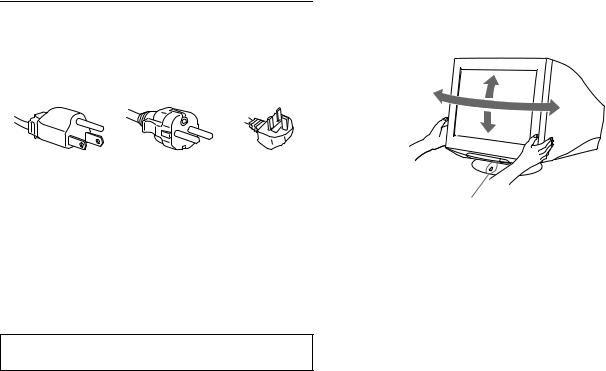
Precautions
Warning on power connections
Use an appropriate power cord for your local power supply.
Example of plug types
for 100 to 120 V AC for 200 to 240 V AC for 240 V AC only
•Before disconnecting the power cord, wait at least 30 seconds after turning off the power to allow the static electricity on the screen’s surface to discharge.
•After the power is turned on, the screen is demagnetized (degaussed) for about a few seconds. This generates a strong magnetic field around the screen which may affect data stored on magnetic tapes and disks placed near the monitor. Be sure to keep magnetic recording equipment, tapes, and disks away from the monitor.
The equipment should be installed near an easily accessible outlet.
Installation
Do not install the monitor in the following places:
•on surfaces (rugs, blankets, etc.) or near materials (curtains, draperies, etc.) that may block the ventilation holes
•near heat sources such as radiators or air ducts, or in a place subject to direct sunlight
•in a place subject to severe temperature changes
•in a place subject to mechanical vibration or shock
•on an unstable surface
•near equipment which generates magnetism, such as a transformer or high voltage power lines
•near or on an electrically charged metal surface
Maintenance
•Clean the screen with a soft cloth. If you use a glass cleaning liquid, do not use any type of cleaner containing an anti-static solution or similar additive as this may scratch the screen’s coating.
•Do not rub, touch, or tap the surface of the screen with sharp or abrasive items such as a ballpoint pen or screwdriver. This type of contact may result in a scratched picture tube.
•Clean the cabinet, panel and controls with a soft cloth lightly moistened with a mild detergent solution. Do not use any type of abrasive pad, scouring powder or solvent, such as alcohol or benzene.
Transportation
When you transport this monitor for repair or shipment, use the original carton and packing materials.
Use of the tilt-swivel
This monitor can be adjusted within the angles shown below. To find the center of the monitor’s turning radius, align the center of the monitor’s screen with the centering dot on the stand.
Hold the monitor at the bottom with both hands when you turn it horizontally or vertically. Be careful not to pinch your fingers at the back of the monitor when you tilt the monitor up vertically.
90° |
15° |
|
|
|
90° |
|
5° |
Centering dot
4
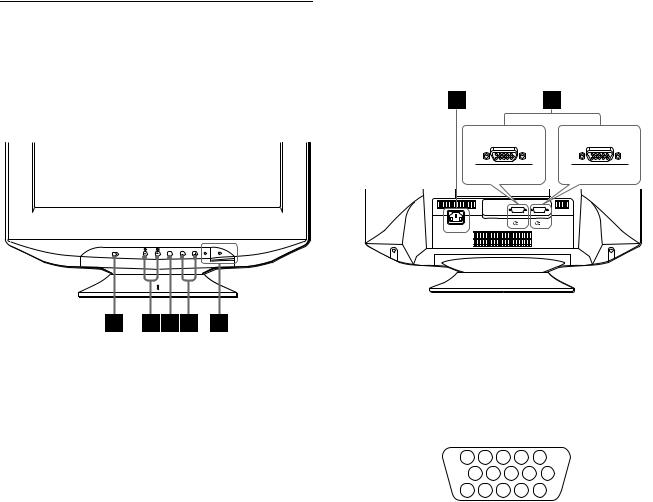
Identifying parts and controls
See the pages in parentheses for further details.
Front
|
INPUT |
MENU |
1 |
2 |
OK |
1INPUT (input) switch (page 8)
This switch selects the INPUT 1 (video input 1 connector: y1) or INPUT 2 (video input 2 connector: y2).
26 (contrast)/m and (brightness)/M buttons
(brightness)/M buttons
(page 10)
These buttons are used to display the CONTRAST/BRIGHT menu directly and to select the menu items.
3MENU/OK button (page 10)
This button is used to display the menu and to activate the selecting/adjusting menu.
4–/+ buttons (page 10)
These buttons are used to make adjustments to the menu.
5! (power) switch and indicator (pages 7, 17, 21)
This button turns the monitor on and off. The power indicator lights up in green when the monitor is turned on, and lights up in orange when the monitor is in power saving mode.
Rear
forward side |
forward side |
rear side |
rear side |
2 |
1 |
AC IN |
|
6AC IN connector (page 7)
This connector provides AC power to the monitor.
7 Video input connectors (HD15) (y1/y2) (page 6) |
GB |
|||||||
These connectors input RGB video signals (0.700 Vp-p, |
|
|||||||
positive) and sync signals. |
|
|
|
|
|
|||
|
5 |
|
4 |
3 |
2 |
1 |
|
|
|
10 |
9 |
8 |
7 |
6 |
|
|
|
|
15 |
14 |
13 12 |
11 |
|
|
||
|
|
|
|
|
|
|
|
|
Pin No. |
Signal |
|
|
|
|
|
|
|
|
|
|
|
|
|
|
|
|
1 |
Red |
|
|
|
|
|
|
|
|
|
|
|
|
||||
2 |
Green (Sync on Green) |
|
|
|
||||
|
|
|
|
|
|
|
|
|
3 |
Blue |
|
|
|
|
|
|
|
|
|
|
|
|
|
|
|
|
4 |
ID (Ground) |
|
|
|
|
|
|
|
|
|
|
|
|
|
|
||
5 |
DDC Ground* |
|
|
|
|
|
||
|
|
|
|
|
|
|
|
|
6 |
Red Ground |
|
|
|
|
|
|
|
|
|
|
|
|
|
|
||
7 |
Green Ground |
|
|
|
|
|
||
|
|
|
|
|
|
|
||
8 |
Blue Ground |
|
|
|
|
|
||
|
|
|
|
|
|
|
|
|
9 |
DDC + 5V* |
|
|
|
|
|
|
|
|
|
|
|
|
|
|
|
|
10 |
Ground |
|
|
|
|
|
|
|
|
|
|
|
|
|
|
|
|
11 |
ID (Ground) |
|
|
|
|
|
|
|
|
|
|
|
|||||
12 |
Bi-Directional Data (SDA)* |
|
||||||
|
|
|
|
|
|
|
|
|
13 |
H. Sync |
|
|
|
|
|
|
|
|
|
|
|
|
|
|
|
|
14 |
V. Sync |
|
|
|
|
|
|
|
|
|
|
|
|
|
|||
15 |
Data Clock (SCL)* |
|
|
|
|
|||
|
|
|
|
|
|
|
|
|
* DDC (Display Data Channel) is a standard of VESA.
5
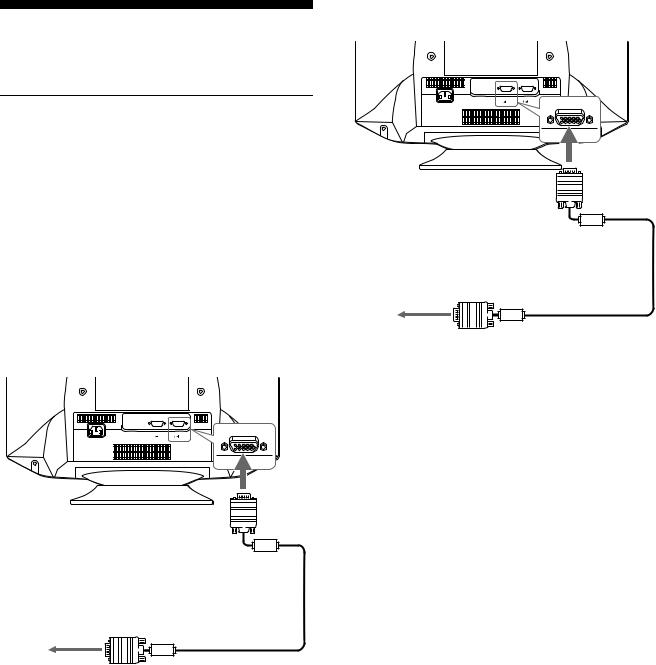
Setup
This monitor works with platforms running at horizontal frequencies between 30 and 130 kHz.
Step 1:Connect your monitor to your computer
Turn off the monitor and computer before connecting.
Connect the appropriate end of the video signal cable to the video output of your computer.
Connect the other end of the video signal cable to the appropriate input of the monitor.
Notes
•Do not touch the pins of the video signal cable connector as this might bend the pins.
•When connecting the video signal cable, check the alignment of the HD15 connector. Do not force the connector in the wrong way or the pins might bend.
x Connecting to the first computer
x Connecting to a second computer
2 |
1 |
AC IN
to HD15
to video output of the computer
video signal cable
2 |
1 |
AC IN
to HD15
to video output of the computer
video signal cable
6

Step 2:Connect the power cord
With the monitor and computer switched off, first connect the power cord to the monitor, then connect it to a power outlet.
2 |
1 |
AC IN
to AC IN
to a power outlet
power cord (supplied)
If no picture appears on your screen
•Check that the monitor is correctly connected to the computer.
•If NO SIGNAL appears on the screen, try changing the input signal (page 8), and confirm that your computer’s graphics board is completely seated in the correct bus slot.
•If you are replacing an old monitor with this model and OUT OF SCAN RANGE appears on the screen, reconnect the old monitor. Then adjust the computer’s graphics board so that the horizontal frequency is between 30 – 130 kHz and the vertical frequency is between 48 – 170 Hz.
For more information about the on-screen messages, see “Trouble symptoms and remedies” on page 19.
Step 3:Turn on the monitor and computer
First turn on the monitor, then turn on the computer.
GB
The installation of your monitor is complete.
If necessary, use the monitor’s controls to adjust the picture.
7
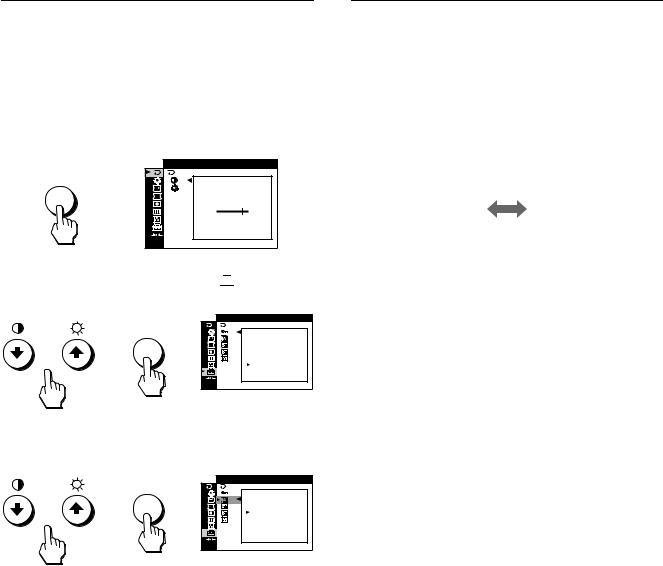
Selecting the on-screen menu language (LANGUAGE)
English, French, German, Spanish, Italian, Dutch, Swedish, Russian and Japanese versions of the on-screen menus are available. The default setting is English.
1Press the MENU/OK button.
The menu appears on the screen.
MENU |
|
EX I T |
|
|
|
||
OK |
b |
CONTRAST |
|
85 |
|||
|
|
||
|
|
1 6 0 0 x 1 2 0 0 / 8 5 H z |
2Press the m/M buttons to highlight 


 OPTION and press the MENU/OK button.
OPTION and press the MENU/OK button.
MENU |
OPT I ON |
|
|
|
CONTROL |
OK |
LOCK |
ON |
|
b b |
OFF |
1 6 0 0 x 1 2 0 0 / 8 5 H z |
3Press the m/M buttons to highlight 
 LANGUAGE and press the MENU/OK button.
LANGUAGE and press the MENU/OK button.
MENU |
|
OPT I ON |
|
|
|
||
OK |
|
LANGUAGE |
|
|
ENGL I SH |
||
b |
b |
FRANÇA I S |
|
DEUTSCH |
|||
1/3 |
|||
1 6 0 0 x 1 2 0 0 / 8 5 H z |
|||
|
|
4Press the m/M buttons until the desired language appears on the screen. Then press the MENU/OK button to select the language.
Each time you press the m/M buttons, the language can be selected appears cyclically.
•ENGLISH
•FRANÇAIS: French
•DEUTSCH: German
•ESPAÑOL: Spanish
•ITALIANO: Italian
•NEDERLANDS: Dutch
•SVENSKA: Swedish
•


 : Russian
: Russian
•
 : Japanese
: Japanese
To close the menu
Press the m/M buttons to select  . If no buttons are pressed, the menu closes automatically after about 30 seconds.
. If no buttons are pressed, the menu closes automatically after about 30 seconds.
To reset to English
Select ENGLISH in step 4 above.
Selecting the input signal
You can connect two computers to this monitor using the HD15 connectors. To select one of the two computers, use the INPUT switch.
Move the INPUT switch.
The selected connector appears on the screen for 3 seconds.
INPUT
1  2
2
“INPUT 1” or “INPUT 2” appears on the screen.
Note
If no signal is input to the selected connector, NO SIGNAL appears on the screen. After a few seconds, the monitor enters the power saving mode. If this happens, switch to the other connector.
8
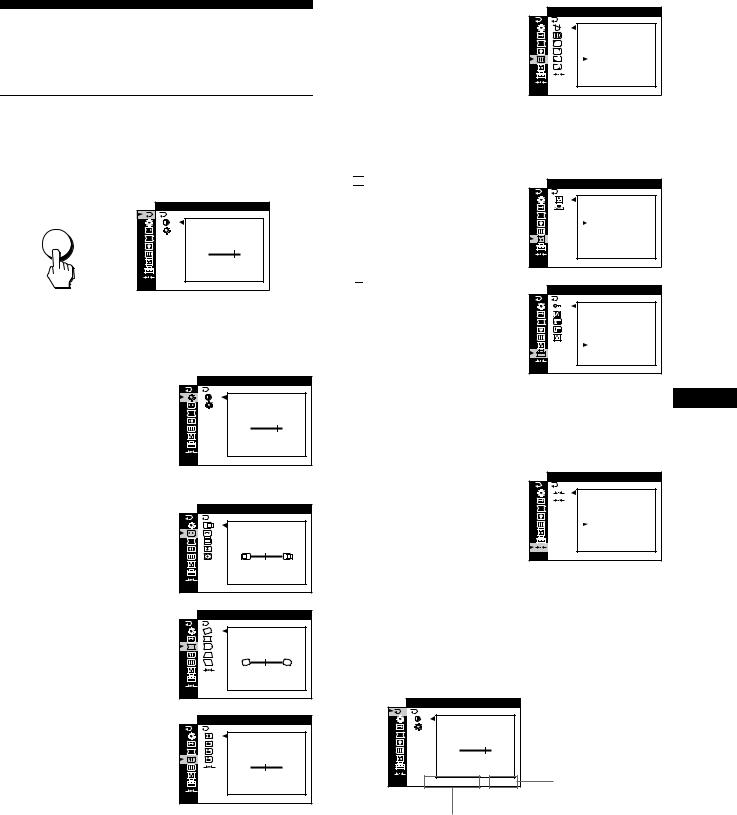
Customizing Your Monitor
You can make numerous adjustments to your monitor using the on-screen menu.
Navigating the menu
Press the MENU/OK button to display the menu on the screen. See page 10 for more information on using the MENU/OK, m/M and –/+ buttons.
MENU |
EX I T |
|
|
|
CONTRAST |
OK |
b |
|
85 |
|
1 6 0 0 x 1 2 0 0 / 8 5 H z |
Use the m/M buttons to select one of the following menus.
 EXIT
EXIT
Close the menu.
 CONTRAST/ BRIGHTNESS (page 10)
CONTRAST/ BRIGHTNESS (page 10)
Adjusts the contrast and brightness. You can also call up this menu directly by pressing the 6/m or  /M buttons while there is no menu on the screen.
/M buttons while there is no menu on the screen.
CONTRAST / BR I GHT
CONTRAST |
85 |
1 6 0 0 x 1 2 0 0 / 8 5 H z |
 SIZE/CENTER (page 11)
SIZE/CENTER (page 11)
Adjusts the size or centering.
 GEOMETRY (page 12)
GEOMETRY (page 12)
Adjusts the rotation and shape of the picture.
 CONVERGENCE (page 12)
CONVERGENCE (page 12)
Adjusts the picture’s horizontal and vertical convergence.
S I ZE / CENTER |
45 |
1 6 0 0 x 1 2 0 0 / 8 5 H z |
GEOMETRY |
45 |
1 6 0 0 x 1 2 0 0 / 8 5 H z |
CONVERGENCE |
T |
B |
45 |
1 6 0 0 x 1 2 0 0 / 8 5 H z |
 SCREEN (page 13)
SCREEN (page 13)
Adjusts the picture’s quality.
The options include:
•degaussing the screen (DEGAUSS)
•adjusting the moire cancellation (CANCEL MOIRE)
•adjusting the landing (LANDING)


 COLOR (page 14)
COLOR (page 14)
Adjusts the picture’s color temperature to match the monitor’s colors to a printed picture’s colors.


 OPTION (page 16)
OPTION (page 16)
Adjusts the monitor’s options.
The options include:
•locking the controls
•changing the on-screen menu’s language
•changing the on-screen menu position
•changing the picture’s color temperature setting mode
SCREEN |
DEGAUSS |
OK |
CANCEL |
1 6 0 0 x 1 2 0 0 / 8 5 H z |
COLOR |
: PRESET |
|
9 3 0 0 K |
|
6 5 0 0 K |
|
5 0 0 0 K |
1 6 0 0 x 1 2 0 0 / 8 5 H z |
|
OPT I ON
CONTROL |
LOCK |
ON |
OFF |
1 6 0 0 x 1 2 0 0 / 8 5 H z |
GB
0RESET (page 16) |
RESET |
|
Resets the adjustments. |
1 |
|
|
2 |
CURRENT |
|
|
MODE |
|
|
OK |
|
|
CANCEL |
|
1 6 0 0 x 1 2 0 0 / 8 5 H z |
|
x Displaying the current input signal
When you press the MENU/OK button to display the menu, the horizontal/vertical frequencies of the current input signal are displayed in the menu. If the signal matches one of this monitor’s factory preset modes (Appendix), the resolution is also displayed. If the current input signal does not match one of the factory presets, the holizontal and vertical frequencies are displayed.
EX I T |
CONTRAST |
85 |
1 6 0 0 x 1 2 0 0 / 8 5 H z |
the horizontal frequencies/ resolution of the current input signal
the vertical frequencies of the current input signal
(continued)
9
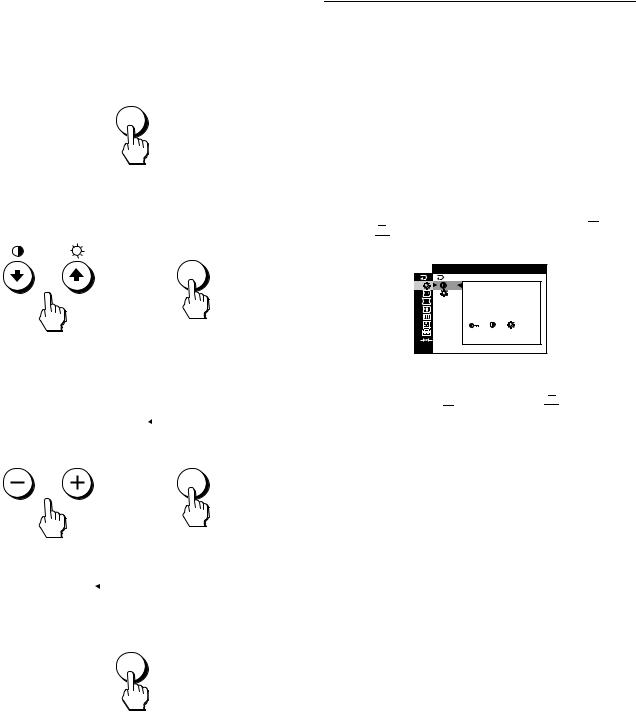
x Using the MENU/OK, m/M and –/+ buttons
1Display the menu.
Press the MENU/OK button to display the menu on the screen.
MENU
OK
2Select the menu you want to adjust.
Highlight the desired menu by pressing the m/M buttons. Then press the MENU/OK button.
MENU
b OK
3Adjust the menu.
Press the –/+ buttons to make the adjustment and press the MENU/OK button.
If you want to select another menu;
move the m/M buttons to select  and press the MENU/OK button to exit the menu.
and press the MENU/OK button to exit the menu.
MENU
b OK
4Close the menu.
Each time you select  and the MENU/OK button, the menu closes. If no buttons are pressed, the menu closes
and the MENU/OK button, the menu closes. If no buttons are pressed, the menu closes
automatically after about 30 seconds.
MENU
OK
Adjusting the brightness and contrast (CONTRAST/BRIGHT)
These settings are stored in memory for the signals from the currently selected input connector.
1Press 6 (contrast) /m or  (brightness) /M button.
(brightness) /M button.
The CONTRAST/BRIGHT menu appears on the screen.
2Press the –/+ buttons to adjust the contrast (6) or brightness ( ).
).
If you are using the sRGB mode
If you selected the sRGB mode in the COLOR MODE ( 
 ) of the OPTION (
) of the OPTION ( ) menu, the following CONTRAST/BRIGHT menu appears on the screen.
) menu, the following CONTRAST/BRIGHT menu appears on the screen.
CONTRAST / BR I GHT
s RGB |
|
: |
/ |
1 6 0 0 x 1 2 0 0 / 8 5 H z |
|
You cannot adjust the contrast (6) or brightness ( ) on this screen. If you want to adjust them, select a mode other than sRGB in the COLOR MODE (
) on this screen. If you want to adjust them, select a mode other than sRGB in the COLOR MODE ( 
 ) of the OPTION (
) of the OPTION (


 ) menu.
) menu.
For more information about using the sRGB mode, see “Adjusting the color of the picture (COLOR)” on page 14.
10

Adjusting the centering of the picture (SIZE/CENTER)
This setting is stored in memory for the current input signal.
1Press the MENU/OK button.
The menu appears on the screen.
2Press the m/M buttons to highlight  SIZE/CENTER and press the MENU/OK button.
SIZE/CENTER and press the MENU/OK button.
The SIZE/CENTER menu appears on the screen.
3Press the m/M buttons to select 
 for horizontal adjustment, or
for horizontal adjustment, or  for vertical adjustment. Then press the MENU/OK button.
for vertical adjustment. Then press the MENU/OK button.
4Press the –/+ buttons to adjust the centering.
Adjusting the size of the picture (SIZE/CENTER)
This setting is stored in memory for the current input signal.
1Press the MENU/OK button.
The menu appears on the screen.
2Press the m/M buttons to highlight  SIZE/CENTER and press the MENU/OK button.
SIZE/CENTER and press the MENU/OK button.
The SIZE/CENTER menu appears on the screen.
3Press the m/M buttons to select  for horizontal adjustment, or
for horizontal adjustment, or  for vertical adjustment. Then press the MENU/OK button.
for vertical adjustment. Then press the MENU/OK button.
4Press the –/+ buttons to adjust the size.
Automatically sizing and centering the picture (AUTO)
You can easily adjust the picture to fill the screen by using the SIZE/CENTER menu.
1Press the MENU/OK button.
The menu appears on the screen.
2Press the m/M buttons to highlight  SIZE/CENTER and press the MENU/OK button.
SIZE/CENTER and press the MENU/OK button.
The SIZE/CENTER menu appears on the screen.
3Press the m/M buttons to select  (AUTO). Then press the MENU/OK button.
(AUTO). Then press the MENU/OK button.
The adjustment window appears on the screen.
4Press the m/M buttons to select OK. Then press the
MENU/OK button.
The picture automatically fills the screen.
GB
Notes
•If you do not want to use the AUTO function, select CANCEL in step 4.
•This function is intended for use with a computer running graphic user interface software that provides a full-screen picture. It may not work properly if the background color is dark or if the input picture does not fill the screen to the edges.
•The displayed image moves for a few seconds while this function is performed. This is not a malfunction.
11

Adjusting the shape of the picture (GEOMETRY)
The GEOMETRY settings allow you to adjust the rotation and shape of the picture.
The  (rotation) setting is stored in memory for all input signals. All other settings are stored in memory for the current input signal.
(rotation) setting is stored in memory for all input signals. All other settings are stored in memory for the current input signal.
1Press the MENU/OK button.
The menu appears on the screen.
2Press the m/M buttons to highlight  GEOMETRY and press the MENU/OK button.
GEOMETRY and press the MENU/OK button.
The GEOMETRY menu appears on the screen.
3Press the m/M buttons to select the desired adjustment item. Then press the MENU/OK button.
The adjustment bar appears on the screen.
4Press the –/+ buttons to make the adjustment.
Select To
rotate the picture
expand or contract the picture sides
shift the picture sides to the left or right
adjust the picture width at the top of the screen
shift the picture to the left or right at the top of the screen
0reset all the GEOMETRY adjustments to the
RESET |
factory setting levels. Select OK. |
|
|
For more information about using the RESET mode, see “Resetting the adjustments (RESET)” on page 16.
Adjusting the convergence (CONVERGENCE)
The CONVERGENCE settings allow you to adjust the quality of the picture by controlling the convergence. The convergence refers to the alignment of the red, green, and blue color signals. If you see red or blue shadows around letters or lines, adjust the convergence.
These settings are stored in memory for all input signals.
1Press the MENU/OK button.
The menu appears on the screen.
2Press the m/M buttons to highlight
 CONVERGENCE and press the MENU/OK button.
CONVERGENCE and press the MENU/OK button.
The CONVERGENCE menu appears on the screen.
3Press the m/M buttons to select the desired adjustment item. Then press the MENU/OK button.
The adjustment bar appears on the screen.
4Press the –/+ buttons to make the adjustment.
Select |
To |
|||
|
|
|
|
horizontally shift red or blue shadows |
|
|
|
|
|
|
|
|
|
|
|
|
|
|
vertically shift red or blue shadows |
|
|
|
|
|
|
|
|
T |
vertically shift red or blue shadows at the top of |
|
|
|
the screen |
|
TOP |
||||
|
|
|
|
|
|
|
|
B |
vertically shift red or blue shadows at the bottom |
|
|
|
||
BOTTOM |
of the screen |
|||
|
|
|
|
|
0 |
reset all the CONVERGENCE adjustments to |
|||
RESET |
the factory setting levels. Select OK. |
|||
|
|
|
|
|
For more information about using the RESET mode, see “Resetting the adjustments (RESET)” on page 16.
12

Adjusting the picture quality (SCREEN)
The SCREEN settings allow you to degauss (demagnetize) the monitor manually and adjust the picture quality by controlling the moire and landing.
•If the color is not uniform or picture is fuzzy, degauss the monitor (DEGAUSS).
•If elliptical or wavy patterns appear on the screen, cancel the moire (CANCEL MOIRE).
•If the color is irregular at the corners of the screen, adjust the landing (LANDING).
The monitor is automatically demagnetized (degaussed) when the power is turned on.
The screen is degaussed for about 2 seconds. If a second degauss cycle is needed, allow a minimum interval of 20 minutes for the best result.
The CANCEL MOIRE setting is stored in memory for the current input signal. All other settings are stored in memory for all input signals.
1Press the MENU/OK button.
The menu appears on the screen.
2Press the m/M buttons to highlight  SCREEN and press the MENU/OK button.
SCREEN and press the MENU/OK button.
The SCREEN menu appears on the screen.
3Press the m/M buttons to select the desired adjustment item. Then press the MENU/OK button.
The adjustment bar appears on the screen.
4Press the m/M or –/+ buttons to make selection/ adjustment.
Select |
To |
|
|
degauss the monitor. To degauss the monitor |
|
DEGAUSS |
manually, select OK. |
|
|
|
|
CANCEL |
adjust the degree of moire cancellation until |
|
the moire is at a minimum |
||
MOIRE* |
||
|
|
|
|
reduce any color irregularities in the screen’s |
|
LANDING |
top left corner to a minimum |
|
|
|
|
|
reduce any color irregularities in the screen’s |
|
LANDING |
top right corner to a minimum |
|
|
|
|
|
reduce any color irregularities in the screen’s |
|
LANDING |
bottom left corner to a minimum |
|
|
|
|
|
reduce any color irregularities in the screen’s |
|
LANDING |
bottom right corner to a minimum |
|
|
|
|
0 |
reset all the SCREEN adjustments to the |
|
RESET |
factory setting levels. Select OK. |
|
|
|
*Moire is a type of natural interference which produces soft, wavy lines on your screen. It may appear due to interference between the pattern of the picture on the screen and the phosphor pitch pattern of the monitor.
Example of moire
GB
Note
The picture may become fuzzy when the CANCEL MOIRE function is activated.
13

Adjusting the color of the picture (COLOR)
The COLOR settings allow you to adjust the picture’s color temperature by changing the color level of the white color field. Colors appear reddish if the temperature is low, and bluish if the temperature is high. This adjustment is useful for matching the monitor’s color to a printed picture’s colors.
You can set the color temperature for each of the video input connectors.
x Select the COLOR mode
There are 4 types of adjustment modes, PRESET, VARIABLE, EXPERT, and sRGB. The default setting is PRESET which can be adjustable to 9300K, 6500K, or 5000K.
If you want to set another mode (other than PRESET), select the desired mode in the OPTION (


 ) menu. Then adjust the selected mode in each COLOR (
) menu. Then adjust the selected mode in each COLOR (

 ) menu.
) menu.
1Press the MENU/OK button.
The menu appears on the screen.
2Press the m/M buttons to highlight  OPTION and press the MENU/OK button.
OPTION and press the MENU/OK button.
The OPTION menu appears on the screen.
3Press the m/M buttons to highlight 

 COLOR
COLOR
MODE. Then press the MENU/OK button.
4Press the m/M buttons to select the COLOR mode.
OPT I ON
COLOR MODE |
PRESET |
VARIABLE |
EXPERT |
s RGB |
1 6 0 0 x 1 2 0 0 / 8 5 H z |
x PRESET mode
1Press the MENU/OK button.
The menu appears on the screen.
2Press the m/M buttons to highlight 
 COLOR and press the MENU/OK button.
COLOR and press the MENU/OK button.
The COLOR menu appears on the screen.
3Press the m/M buttons to highlight 
 . Then press the MENU/OK button.
. Then press the MENU/OK button.
The adjustment bar appears.
COLOR |
: PRESET |
|
9 3 0 0 K |
|
6 5 0 0 K |
|
5 0 0 0 K |
1 6 0 0 x 1 2 0 0 / 8 5 H z |
|
4Press the m/M buttons to select the desired temperature.
The preset color temperatures are 9300K, 6500K, and 5000K. Since the default setting is 9300K, the whites will change from a bluish hue to a reddish hue as the temperature is lowered to 6500K and 5000K.
x VARIABLE mode
1Press the MENU/OK button.
The menu appears on the screen.
2Press the m/M buttons to highlight 
 COLOR and press the MENU/OK button.
COLOR and press the MENU/OK button.
The COLOR menu appears on the screen.
3Press the m/M buttons to highlight 
 . Then press the MENU/OK button.
. Then press the MENU/OK button.
The adjustment bar appears.
COLOR : VARIABLE
5 0 0 0 K |
1 6 0 0 x 1 2 0 0 / 8 5 H z |
4Press the –/+ buttons to fine tune the color temperature.
The new color temperature setting you fine tuned between 5000K to 11000K is stored in memory.
14
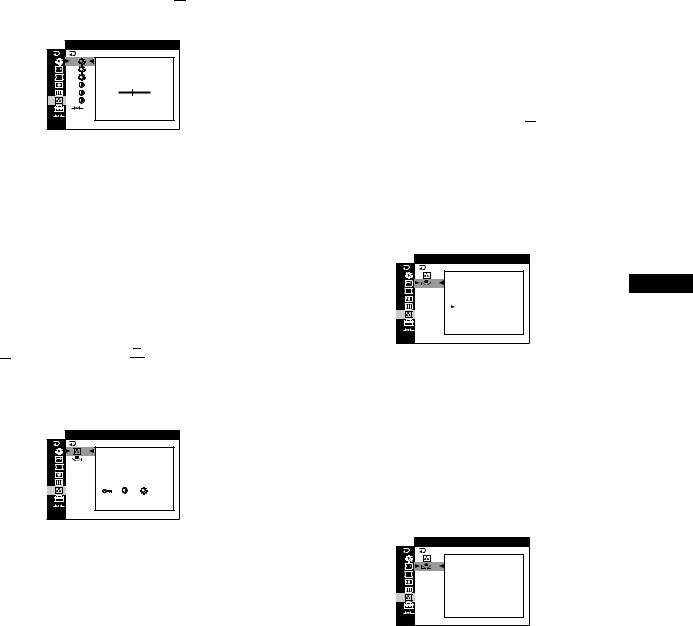
x EXPERT mode
You can make additional adjustments to the color in greater detail by selecting the EXPERT mode.
1Press the MENU/OK button.
The menu appears on the screen.
2Press the m/M buttons to highlight 

 COLOR and press the MENU/OK button.
COLOR and press the MENU/OK button.
The COLOR menu appears on the screen.
COLOR : EXPERT
R |
|
G |
|
B |
|
R |
|
G |
|
B |
45 |
|
1 6 0 0 x 1 2 0 0 / 8 5 H z |
3Press the m/M buttons to select the R (red), G
(green), and B (blue) component of input signal for each of GAIN (6) and BIAS ( ). Then press the –/+ button to make the adjustment.
). Then press the –/+ button to make the adjustment.
If you want to reset the EXPERT adjustments, select
0(RESET) in COLOR menu. Then select OK in the RESET window.
x sRGB mode
The sRGB color setting is an industry standard color space protocol designed to correlate the displayed and printed colors of sRGB compliant computer products. To adjust the colors to the sRGB profile, simply select the sRGB mode in the COLOR MODE (
 ) menu of the OPTION (
) menu of the OPTION ( ) menu.
) menu.
However, in order to display the sRGB colors correctly (γ = 2.2, 6500K), you must set your computer to the sRGB profile. If you select this mode, you cannot operate the CONTRAST/BRIGHT menu adjustments.
COLOR : sRGB
s RGB |
|
: |
/ |
1 6 0 0 x 1 2 0 0 / 8 5 H z |
|
Note
Your computer must be sRGB compliant.
Restoring the color from the EASY, PRESET, or sRGB modes (COLOR RETURN)
The colors of most display monitors tend to gradually change brilliance over several years of service. The COLOR RETURN feature found in the PRESET, VARIABLE and sRGB modes allows you to restore the color to the original factory quality levels. The explanation below explains how to restore the monitor’s color from the PRESET mode for example.
First, select the PRESET, VARIABLE or sRGB mode in the OPTION menu (page 14).
1Press the MENU/OK button.
The menu appears on the screen.
2Press the m/M buttons to highlight 
 COLOR and press the MENU/OK button.
COLOR and press the MENU/OK button.
The COLOR menu appears on the screen.
3Press the m/M buttons to highlight  COLOR
COLOR
RETURN. Then press the MENU/OK button.
4Press the m/M buttons to select OK. Then press the
MENU/OK button.
COLOR |
: PRESET |
|
|
COLOR |
GB |
|
RETURN |
|
|
OK |
|
|
CANCEL |
|
1 6 0 0 x 1 2 0 0 / 8 5 H z |
|
|
The picture disappears while the color is being restored (about 2 seconds). After the color is restored, the picture reappears on the screen again.
Notes
•Before using this feature, the monitor must be in normal operation mode (green power indicator on) for at least 30 minutes. If the monitor goes into power saving mode, you must return the monitor to normal operation mode and wait for 30 minutes for the monitor to be ready. You may need to adjust your computer’s power saving settings to keep the monitor in normal operation mode for the full 30 minutes. If the monitor is not ready, the following message will appear.
COLOR |
: PRESET |
|
COLOR |
|
RETURN |
|
AVA I LABLE |
|
AFTER |
|
WARM UP |
1 6 0 0 x 1 2 0 0 / 8 5 H z |
|
•The monitor may gradually lose its ability to perform this function due to the natural aging of the picture tube.
15
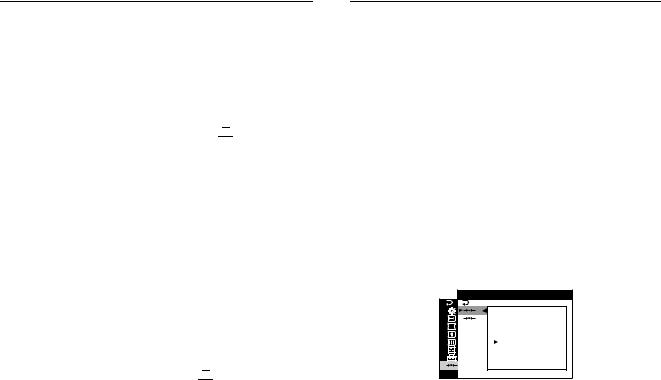
Additional settings (OPTION)
You can lock the controls, change the on-screen language, change the menu position, and set the COLOR mode.
1Press the MENU/OK button.
The menu appears on the screen.
2Press the m/M buttons to highlight  OPTION and press the MENU/OK button.
OPTION and press the MENU/OK button.
The OPTION menu appears on the screen.
3Press the m/M buttons to select the desired adjustment item.
Adjust the selected item according to the following instructions.
x Locking the controls (CONTROL LOCK)
You can protect the adjustment data by locking the controls.
Press the m/M buttons to highlight  (CONTROL
(CONTROL
LOCK) and press the MENU/OK button. Then press the m/M buttons to select ON and press the MENU/OK button.
Only the ! (power) switch, MENU/OK button, INPUT switch,  , and
, and  (CONTROL LOCK) of the
(CONTROL LOCK) of the  OPTION menu will operate. If any other items are selected, the
OPTION menu will operate. If any other items are selected, the  mark appears on
mark appears on
the screen.
To cancel the control lock
Repeat the procedure above and set  (CONTROL LOCK) to OFF.
(CONTROL LOCK) to OFF.
x Changing the on-screen language
(LANGUAGE)
See page 8.
x Changing the menu’s position
(OSD POSITION)
Change the menu’s position if it is blocking an image on the screen.
Press the m/M buttons to select  (OSD POSITION) for horizontal adjustment, or
(OSD POSITION) for horizontal adjustment, or  (OSD POSITION) for vertical adjustment and press the MENU/OK button. Then press the –/+ button to shift the on-screen menu.
(OSD POSITION) for vertical adjustment and press the MENU/OK button. Then press the –/+ button to shift the on-screen menu.
x Setting the COLOR mode
See page 14.
Resetting the adjustments (RESET)
This monitor has the following 2 reset methods.
xResetting all the adjustment data for the current input signal
1Press the MENU/OK button.
The menu appears on the screen.
2Press the m/M buttons to highlight 0 RESET and press the MENU/OK button.
3Press the m/M buttons to select 01 and press the
MENU/OK button.
4Press the m/M buttons to select OK. Then press the
MENU/OK button.
RESET |
|
1 |
|
2 |
CURRENT |
|
MODE |
|
OK |
|
CANCEL |
1 6 0 0 x 1 2 0 0 / 8 5 H z |
|
Note that the following items are not reset by this method:
•on-screen menu language (page 8)
•color mode setting in the OPTION menu (PRESET, VARIABLE, EXPERT, sRGB) (page 14)
•color temperature setting in the PRESET mode (9300K, 6500K, 5000K) (page 15)
•on-screen menu position (page 16)
x Resetting all of the adjustment data for all input signals
Select 02 in step 3 above.
Note
The RESET function does not function when  (CONTROL LOCK) is set to ON.
(CONTROL LOCK) is set to ON.
16
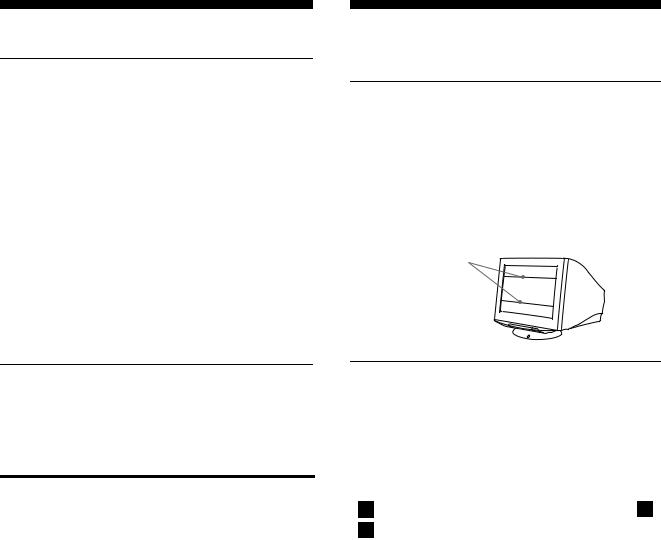
Technical Features
Preset and user modes
When the monitor receives an input signal, it automatically matches the signal to one of the factory preset modes stored in the monitor’s memory to provide a high quality picture at the center of the screen. (See Appendix for a list of the factory preset modes.) For input signals that do not match one of the factory preset modes, the digital Multiscan technology of this monitor ensures that a clear picture appears on the screen for any timing in the monitor’s frequency range (horizontal: 30 – 130 kHz, vertical: 48 – 170 Hz). If the picture is adjusted, the adjustment data is stored as a user mode and automatically recalled whenever the same input signal is received.
Note for Windows users
For Windows users, check your graphics board manual or the utility program which comes with your graphics board and select the highest available refresh rate to maximize monitor performance.
Troubleshooting
Before contacting technical support, refer to this section.
If thin lines appear on your screen (damper wires)
The visible lines on your screen especially when the background screen color is light (usually white), are normal for the Trinitron monitor. This is not a malfunction. These are shadows from the damper wires used to stabilize the aperture grille. The aperture grille is the essential element that makes a Trinitron picture tube unique by allowing more light to reach the screen, resulting in a brighter, more detailed picture.
Damper wires
Power saving function
This monitor meets the power-saving guidelines set by VESA and ENERGY STAR. If no signal is input to the monitor from your computer, the monitor will automatically reduce power consumption as shown below.
Power mode |
Power consumption |
! (power) |
|
|
indicator |
|
|
|
normal |
≤ 135 W |
green |
operation |
|
|
|
|
|
active off* |
≤ 3 W |
orange |
(deep sleep)** |
|
|
|
|
|
power off |
Approx. 0 W |
off |
|
|
|
*When your computer enters power saving mode, the input signal is cut and NO SIGNAL appears on the screen before the monitor enters active off mode. After a few seconds, the monitor enters power saving mode.
**“Deep sleep” is power saving mode defined by the Environmental Protection Agency.
On-screen messages
If there is something wrong with the input signal, one of the |
GB |
||||||||||||||
|
|||||||||||||||
following messages appears on the screen. |
|
|
|
|
|||||||||||
If NO SIGNAL appears on section 1 |
|
|
|
|
|||||||||||
This indicates that no signal is input from the selected connector. |
|
||||||||||||||
|
|
|
|
|
|
|
|
|
|
|
|
|
|
|
|
|
|
|
I NFORMAT I ON |
|
|
|
|
|
|
|
|||||
|
|
|
MON I TOR |
I |
S |
WORK I NG |
|
|
|
|
|
|
|||
|
|
|
|
I NPUT |
2 |
: |
NO |
S I GNAL |
|
|
W |
|
|
|
|
|
|
|
|
|
ACT I VATE |
|
BY |
COMPUTER |
|
|
|
|
|
||
|
|
|
|
|
|
|
|
|
|
|
|||||
|
|
|
|
|
CHECK |
S I GNAL |
CABLE |
|
R |
|
|
|
|||
|
|
|
|
|
|
|
|
||||||||
|
|
|
|
|
CHECK |
I NPUT |
SELECTOR |
|
G |
|
|
|
|||
|
|
|
|
|
|
|
|
|
|
|
|
B |
|
|
|
2The selected connector
This message shows the currently selected video input connector (INPUT 1 or INPUT 2).
3The remedies
The following messages appear on the screen.
•If ACTIVATE BY COMPUTER appears on the screen, try pressing any key on the computer or moving the mouse, and confirm that your computer’s graphics board is completely seated in the correct bus slot.
•If CHECK SIGNAL CABLE appears on the screen, check that the monitor is correctly connected to the computer (page 6).
•If CHECK INPUT SELECTOR appears on the screen, try changing the input signal (page 8).
(continued)
17
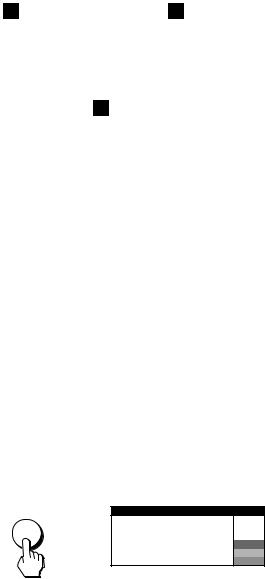
If OUT OF SCAN RANGE appears on line 1
This indicates that the input signal is not supported by the monitor’s specifications.
|
|
|
|
|
|
|
|
|
|
|
|
I NFORMAT I ON |
|
|
|||||
|
|
MONI TOR |
I S WORK I NG |
|
|
|
|||
|
|
I NPUT |
2 : 2 0 0 . 0 k H z / 85Hz |
|
W |
||||
|
|
OUT OF |
SCAN RANGE |
|
|
|
|
||
|
|
|
|
|
|
||||
|
|
|
|
|
|
|
|
|
R |
|
|
CHANGE |
S I GNAL T I M I NG |
|
|
G |
|||
|
|
|
|
|
|
|
|
|
B |
|
|
|
|
|
|
|
|
|
|
2The selected video input connector and the frequencies of the current input signal
This message shows the currently selected video input connector (INPUT 1 or INPUT 2). If the monitor recognizes the frequencies of the current input signal, the horizontal and vertical frequencies are also displayed.
3The remedies
CHANGE SIGNAL TIMING appears on the screen. If you are replacing an old monitor with this monitor, reconnect the old monitor. Then adjust the computer’s graphics board so that the horizontal frequency is between 30 – 130 kHz, and the vertical frequency is between 48 – 170 Hz.
For more information, see “Trouble symptoms and remedies” on page 19.
Displaying this monitor’s name, serial number, and date of manufacture.
While the monitor is receiving a video signal, press and hold the MENU/OK button for more than 5 seconds to display this monitor’s information box.
Example
MENU |
|
INFORMATION |
|
|
|
|
|
OK |
b |
MODEL : GDM-5502 |
|
SER NO : 1234567 |
W |
||
|
MANUFACTURED : 2001-52 |
R |
|
|
|
|
G |
|
|
|
B |
If the problem persists, call your service representative and give the following information.
•Model name: GDM-5502
•Serial number
•Name and specifications of your computer and graphics board.
18

Trouble symptoms and remedies
If the problem is caused by the connected computer or other equipment, please refer to the connected equipment’s instruction manual. Use the self-diagnosis function (page 21) if the following recommendations do not resolve the problem.
Symptom |
Check these items |
|
No picture |
|
|
If the ! (power) indicator is not lit |
• |
Check that the power cord is properly connected. |
|
• |
Check that the ! (power) switch is in the “on” position. |
If the NO SIGNAL message appears on the screen, or if the
! (power) indicator is orange or alternating between green and orange
•Check that the video signal cable is properly connected and all plugs are firmly seated in their sockets (page 6).
•Check that the INPUT switch setting is correct (page 8).
•Check that the video input connector’s pins are not bent or pushed in.
xProblems caused by the connected computer or other equipment
•The computer is in power saving mode. Try pressing any key on the keyboard or moving the mouse.
•Check that the computer’s power is “on.”
•Check that the graphic board is completely seated in the proper bus slot.
If the OUT OF SCAN RANGE xProblems caused by the connected computer or other equipment message appears on the screen • Check that the video frequency range is within that specified for the monitor. If you
replaced an old monitor with this monitor, reconnect the old monitor and adjust the frequency range to the following.
Horizontal: 30 – 130 kHz Vertical: 48 – 170 Hz
If no message is displayed and the • Use the Self-diagnosis function (page 21). ! (power) indicator is green or
flashing orange
GB
Picture flickers, bounces, |
• Isolate and eliminate any potential sources of electric or magnetic fields such as other |
|
oscillates, or is scrambled |
|
monitors, laser printers, fluorescent lighting, televisions, or electric fans. |
|
• Move the monitor away from power lines or place a magnetic shield near the monitor. |
|
|
• |
Try plugging the monitor into a different AC outlet, preferably on a different circuit. |
|
• |
Try turning the monitor 90° to the left or right. |
xProblems caused by the connected computer or other equipment
•Check your graphics board manual for the proper monitor setting.
•Confirm that the graphics mode and the frequency of the input signal are supported by this monitor (Appendix). Even if the frequency is within the proper range, some graphics boards may have a sync pulse that is too narrow for the monitor to sync correctly.
•Adjust the computer’s refresh rate (vertical frequency) to obtain the best possible picture.
Picture is fuzzy |
• Adjust the contrast and brightness (page 10). |
•Degauss the monitor* (page 13).
•Adjust the degree of moire cancellation until the moire is minimal, or set CANCEL MOIRE to OFF (page 13).
*If a second degauss cycle is needed, allow a minimum interval of 20 minutes for the best result. A humming noise may be heard, but this is not a malfunction.
(continued)
19
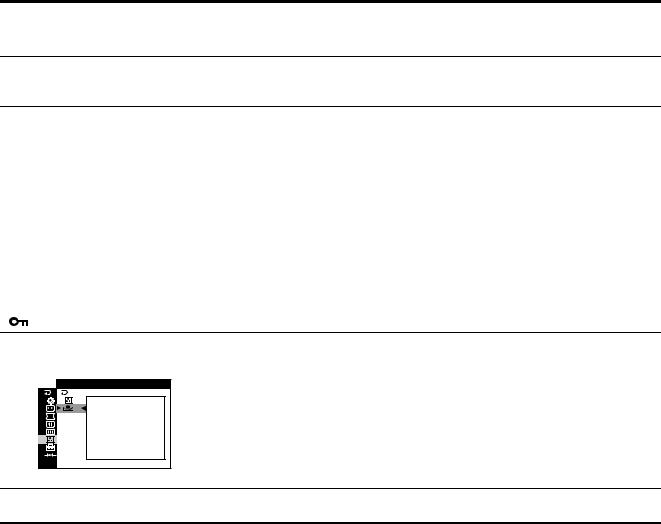
Symptom |
Check these items |
|
Picture is ghosting |
• |
Eliminate the use of video cable extensions and/or video switch boxes. |
|
• |
Check that all plugs are firmly seated in their sockets. |
Picture is not centered or sized properly
•Set the AUTO ( ) function to OK (on) in the SIZE/CENTER menu (page 11).
) function to OK (on) in the SIZE/CENTER menu (page 11).
•Adjust the size or centering (page 11). Note that with some input signals and/or graphics boards the periphery of the screen is not fully utilized.
Edges of the image are curved |
• Adjust the geometry (page 12). |
|
Wavy or elliptical pattern (moire) |
• Adjust the degree of moire cancellation until the moire is minimal (page 13). |
|
is visible |
xProblems caused by the connected computer or other equipment |
|
|
|
|
|
|
• Change your desktop pattern. |
|
|
|
Color is not uniform |
• Degauss the monitor* (page 13). If you place equipment that generates a magnetic field, |
|
|
|
such as a speaker, near the monitor, or if you change the direction the monitor faces, color |
|
|
may lose uniformity. |
|
|
• Adjust the landing (page 13). |
|
|
|
White does not look white |
• Adjust the color temperature (page 14). |
|
|
|
|
Letters and lines show red or blue |
• Adjust the convergence (page 12). |
|
shadows at the edges |
|
|
|
|
|
Monitor buttons do not operate |
• If the control lock is set to ON, set it to OFF (page 16). |
|
( |
appears on the screen) |
|
COLOR RETURN function does not operate
COLOR |
: PRESET |
|
COLOR |
|
RETURN |
|
AVA I LABLE |
|
AFTER |
|
WARM UP |
1 6 0 0 x 1 2 0 0 / 8 5 H z |
|
•Before using this function, the monitor must be in normal operation mode (green power indicator on) for at least 30 minutes. For more information on using the COLOR RETURN function, see page 15.
•Adjust the computer’s power saving settings to keep the monitor in normal operation mode for more than 30 minutes.
•The monitor may gradually lose its ability to perform this function due to the natural aging of the picture tube.
A hum is heard right after the power is turned on
•This is the sound of the auto-degauss cycle. When the power is turned on, the monitor is automatically degaussed for a few seconds.
*If a second degauss cycle is needed, allow a minimum interval of 20 minutes for the best result. A humming noise may be heard, but this is not a malfunction.
20

Self-diagnosis function
Specifications
This monitor is equipped with a self-diagnosis function. If there is a problem with your monitor or computer(s), the screen will go blank and the ! (power) indicator will either light up green or flash orange. If the ! (power) indicator is lit in orange, the computer is in power saving mode. Try pressing any key on the keyboard or moving the mouse.
CRT |
0.24 mm aperture grille pitch |
|
21 inches measured diagonally |
|
90-degree deflection |
|
FD Trinitron |
Viewable image size |
Approx. 403.8 × 302.2 mm (w/h) |
|
(16 × 12 inches) |
|
19.8" viewing image |
|
|
|
Resolution |
|
|
|
|
|
Maximum |
Horizontal: 2048 dots |
|
|
INPUT |
MENU |
|
Vertical: 1536 lines |
|
1 |
2 |
|
|
|
|
|
|
|
|
|
|
|
|
|
Recommended |
Horizontal: 1600 dots |
|
|
! (power) indicator |
|
Vertical: 1200 lines |
|
|
|
Input signal levels |
Video signal |
|
||
|
|
|
|
||
|
|
|
|
Analog RGB: 0.700 Vp-p |
|
x If the ! (power) indicator is green |
|
(positive), 75 Ω |
|
||
|
|
|
|
SYNC signal |
|
1 Disconnect any plugs from the video input 1 and 2 |
|
H/V separate or composite sync: |
|
||
connectors, or turn off the connected computer(s). |
|
TTL 2 kΩ, Polarity free |
|
||
|
|
|
|
Sync on Green: 0.3 Vp-p |
|
2 Press the ! (power) button twice to turn the monitor |
|
(negative) |
|
||
off and then on. |
|
|
Standard image area |
Approx. 388 × 291 mm (w/h) (4:3) |
|
|
|
|
|
(15 3/8 × 11 1/2 inches) |
|
3 Hold the M button upward for 2 seconds before the |
|
or |
|
||
monitor enters power saving mode. |
|
Approx. 364 × 291 mm (w/h) (5:4) |
GB |
||
|
|
|
|
(14 3/8 × 11 1/2 inches) |
|
|
|
|
Deflection frequency* |
Horizontal: 30 to 130 kHz |
|
|
|
|
|
Vertical: 48 to 170 Hz |
|
|
|
|
AC input voltage/current |
100 to 240 V, 50 – 60 Hz, 2.0 – 1.0 A |
|
|
|
|
Power consumption |
Approx. 135 W |
|
|
|
|
Dimensions |
Approx. 497 × 502 × 485 mm (w/h/d) |
|
|
|
|
|
(19 5/8 × 19 × 18 7/8 inches) |
|
If all four color bars appear (white, red, green, blue), the monitor |
Mass |
Approx. 30 kg (66 lb 2 oz) |
|
||
is working properly. Reconnect the video input cables and check |
Plug and Play |
DDC2B/DDC2Bi, GTF (See |
|
||
the condition of your computer(s). |
|
Appendix on page i) |
|
||
If the color bars do not appear, there is a potential monitor failure. |
* Recommended horizontal and vertical timing condition |
Inform your service representative of the monitor’s condition. |
• Horizontal sync width duty should be more than 4.8% of |
|
total horizontal time or 0.8 µsec, whichever is larger. |
x If the ! (power) indicator is flashing orange |
• Horizontal blanking width should be more than 2.3 µsec. |
|
• Vertical blanking width should be more than 450 µsec. |
Press the ! (power) button twice to turn the monitor off |
Design and specifications are subject to change without notice. |
and then on. |
If the ! (power) indicator lights up green, the monitor is working properly.
If the ! (power) indicator is still flashing, there is a potential monitor failure. Count the number of seconds between orange flashes of the ! (power) indicator and inform your service representative of the monitor’s condition. Be sure to note the model name and serial number of your monitor. Also note the make and model of your computer and graphic board.
21

Table des Matières
Précautions. . . . . . . . . . . . . . . . . . . . . . . . . . . . . . . . . . . . . . . . . . . . 4
Identification des pièces et des commandes . . . . . . . . . . . . . . . . . . 5
Installation et configuration . . . . . . . . . . . . . . . . . . . . . . .6
Etape 1: Raccordez votre moniteur à votre ordinateur . . . . . . . . . . 6
Etape 2: Raccordez le cordon d’alimentation secteur . . . . . . . . . . . 7
Etape 3: Mettez le moniteur et l’ordinateur sous tension . . . . . . . . . 7
Sélection de la langue d’affichage à l’écran (LANGUAGE) . . . . . . . 8
Sélection du signal d’entrée . . . . . . . . . . . . . . . . . . . . . . . . . . . . . . . 8
•Trinitronâ est une marque commerciale déposée de Sony Corporation.
•Macintosh est une marque commerciale sous licence d’Apple Computer, Inc., déposée aux Etats-Unis et dans d’autres pays.
•Windowsâ et MS-DOS sont des marques déposées de Microsoft Corporation aux Etats-Unis et dans d’autres pays.
•VESA et DDCä sont des marques commerciales de Video Electronics Standard Association.
•ENERGY STAR est une marque déposée aux Etats-Unis.
•Tous les autres noms de produits mentionnés dans le présent mode d’emploi peuvent être des marques commerciales ou des marques commerciales déposées de leurs sociétés respectives.
•Les symboles “ä” et “â” ne sont pas mentionnés systématiquement dans le présent mode d’emploi.
Personnalisation de votre moniteur. . . . . . . . . . . . . . . . .9
Navigation dans le menu . . . . . . . . . . . . . . . . . . . . . . . . . . . . . . . . . 9 Réglage de la luminosité et du contraste (CONTR/LUMIN) . . . . . . 10 Réglage du centrage de l’image (TAILLE/CENTRAGE). . . . . . . . . 11 Réglage de la taille de l’image (TAILLE/CENTRAGE) . . . . . . . . . . 11 Dimensionnement et centrage automatique de l’image (AUTO) . . 11 Réglage de la forme de l’image (GEOMETRIE) . . . . . . . . . . . . . . . 12 Réglage de la convergence (CONVERGENCE) . . . . . . . . . . . . . . 12 Réglage de la qualité de l’image (ECRAN). . . . . . . . . . . . . . . . . . . 13 FR Réglage de la couleur de l’image (COULEUR) . . . . . . . . . . . . . . . 14 Réglages supplémentaires (OPTION) . . . . . . . . . . . . . . . . . . . . . . 16 Réinitialisation des réglages (REINITIALISATION) . . . . . . . . . . . . 16
Caractéristiques techniques. . . . . . . . . . . . . . . . . . . . . .17
Modes préréglés et personnalisés . . . . . . . . . . . . . . . . . . . . . . . . . 17 Fonction d’économie d’énergie. . . . . . . . . . . . . . . . . . . . . . . . . . . . 17
Guide de dépannage . . . . . . . . . . . . . . . . . . . . . . . . . . . .17
Si des lignes fines apparaissent à l’écran (fils d’amortissement) . . 17 Messages à l’écran. . . . . . . . . . . . . . . . . . . . . . . . . . . . . . . . . . . . . 17 Symptômes et remèdes . . . . . . . . . . . . . . . . . . . . . . . . . . . . . . . . . 19 Fonction d’auto-diagnostic . . . . . . . . . . . . . . . . . . . . . . . . . . . . . . . 21
Spécifications. . . . . . . . . . . . . . . . . . . . . . . . . . . . . . . . . .21
Appendix. . . . . . . . . . . . . . . . . . . . . . . . . . . . . . . . . . . . . . . i
Preset mode timing table . . . . . . . . . . . . . . . . . . . . . . . . . . . . . . . . . .i TCO’99 Eco-document . . . . . . . . . . . . . . . . . . . . . . . . . . . . . . . . . . . .i
3
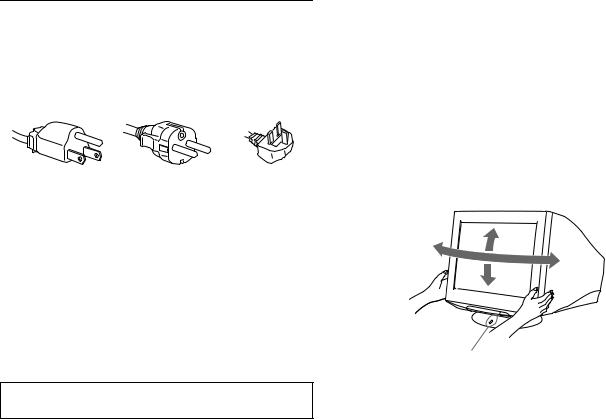
Précautions
Avertissement relatif au raccordement secteur
Utilisez le cordon d’alimentation adapté à votre réseau d’alimentation électrique.
Exemple de types de fiches
pour 100 à 120 V CA pour 200 à 240 V CA pour 240 V CA uniquement
•Avant de débrancher le cordon d’alimentation, attendez au moins 30 secondes après avoir coupè l’alimentation afin de permettre le déchargement de l’électricité statique de la surface de l’écran.
•Après la mise sous tension, l’écran est démagnétisé pendant quelques secondes. Ceci génère un champ magnétique puissant autour de l’écran, susceptible d’altérer les données stockées sur les cassettes, disques ou disquettes placès à proximité du moniteur. Assurez-vous de ne pas placer d’équipement d’enregistrement magnétique, de bandes ou de disquettes à proximité du moniteur.
La prise électrique doit être installée à proximité de l’appareil et facile d’accès.
Installation
N’installez pas le moniteur dans les situations suivantes :
•sur des surfaces textiles (tapis, couvertures, etc.) ni à proximité de tissus (rideaux, draperies, etc.) qui risquent d’obstruer les orifices de ventilation
•près de sources de chaleur telles que des radiateurs ou des conduits d’air chaud ou à un emplacement exposé aux rayons directs du soleil
•dans un endroit sujet à de fortes variations de température
•dans un endroit sujet à des vibrations mécaniques ou à des chocs
•sur une surface instable
•près d’un équipement générant un champ magnétique, tel qu’un transformateur ou des lignes à haute tension
•près ou sur une surface métallique chargée d’électricité
Entretien
•Nettoyez l’écran en utilisant un chiffon doux et sec. Si vous utilisez un nettoyant pour vitres, n’utilisez pas de produits contenant une solution antistatique ou une solution similaire qui risque d’abîmer le revêtement de l’écran.
•Ne frottez pas, ne touchez pas et ne tapotez pas la surface de l’écran avec des objets pointus ou abrasifs, tels que la pointe d’un stylo ou un tournevis. Dans le cas contraire, vous pourriez en effet rayer le tube image.
•Nettoyez le boîtier, l’écran et les commandes à l’aide d’un chiffon doux légèrement imbibé d’une solution détergente douce. N’utilisez pas d’éponge abrasive, de poudre à récurer ou de solvant tel que de l’alcool ou de la benzine.
Transport
Lorsque vous transportez ce moniteur pour l’emmener chez le réparateur ou pour l’expédier quelque part, utilisez le carton et les matériaux d’emballage d’origine.
Utilisation du pied pivotant
Ce moniteur peut être ajusté selon les angles illustrés ci-dessous. Pour trouver le centre du rayon d’ajustement du moniteur, alignez le centre de l’écran avec le point de centrage situé sur le pied.
Tenez avec vos deux mains le moniteur par sa partie inférieure lorsque vous le faites pivoter horizontalement ou verticalement. Veillez à ne pas vous coincer les doigts à l’arrière du moniteur lorsque vous le réglez verticalement.
90° |
15° |
|
|
|
90° |
|
5° |
Point de centrage
4

Identification des pièces et des commandes
Pour obtenir des informations plus détaillées, reportez-vous aux pages dont le numéro est indiqué entre parenthèses.
Avant
|
INPUT |
MENU |
1 |
2 |
OK |
1Commutateur INPUT (entrée) (page 8)
Ce commutateur permet de sélectionner l’entrée INPUT 1 (connecteur d’entrée vidéo 1 : y1) ou l’entrée INPUT 2 (connecteur d’entrée vidéo 2 : y2).
2Touches 6 (contraste) /m et  (luminosité) /M
(luminosité) /M
(page 10)
Ces touches servent à afficher directement le menu CONTR/ LUMIN et à sélectionner les éléments du menu.
3Touche MENU/OK (page 10)
Cette touche sert à afficher le menu et à ouvrir le menu de sélection ou de réglage.
4Touches –/+ (page 10)
Ces touches servent à effectuer des réglages dans le menu.
5Commutateur et indicateur ! (alimentation)
(pages 7, 17, 21)
Cette touche permet d’allumer et d’éteindre le moniteur. L’indicateur d’alimentation s’allume en vert lorsque le moniteur est sous tension et en orange lorsque le moniteur est en mode d’économie d’énergie.
Arrière
côté avant |
côté avant |
côté arrière |
côté arrière |
2 |
1 |
AC IN |
|
6Connecteur AC IN (page 7)
Ce connecteur fournit une alimentation secteur au moniteur.
7 Connecteurs d’entrée vidéo (HD15) (y1/y2) |
FR |
|||||||
(page 6) |
|
|
|
|
|
|
|
|
Ces connecteurs permettent l’entrée de signaux vidéo RVB |
|
|||||||
(0,700 Vp-p, positifs) ainsi que des signaux de |
|
|||||||
synchronisation. |
|
|
|
|
|
|
|
|
|
5 |
|
4 |
3 |
2 |
1 |
|
|
|
10 |
9 |
8 |
7 |
6 |
|
|
|
|
15 |
14 |
13 12 |
11 |
|
|
||
|
|
|
|
|
|
|
||
N° de broche |
Signal |
|
|
|
|
|
||
|
|
|
|
|
|
|
||
1 |
Rouge |
|
|
|
|
|
||
|
|
|
|
|||||
2 |
Vert (Sync sur Vert) |
|
||||||
|
|
|
|
|
|
|
|
|
3 |
Bleu |
|
|
|
|
|
|
|
|
|
|
|
|
|
|||
4 |
ID (Masse) |
|
|
|
|
|||
|
|
|
|
|
||||
5 |
DDC (Masse)* |
|
|
|
||||
|
|
|
|
|
||||
6 |
Masse Rouge |
|
|
|
||||
|
|
|
|
|
|
|||
7 |
Masse Verte |
|
|
|
|
|||
|
|
|
|
|
|
|||
8 |
Masse Bleue |
|
|
|
|
|||
|
|
|
|
|
|
|||
9 |
DDC + 5 V* |
|
|
|
|
|||
|
|
|
|
|
|
|
||
10 |
Masse |
|
|
|
|
|
||
|
|
|
|
|
|
|||
11 |
ID (Masse) |
|
|
|
|
|||
|
|
|
|
|||||
12 |
Données bi-directionnelles (SDA)* |
|
||||||
|
|
|
|
|
|
|
||
13 |
Sync H |
|
|
|
|
|
||
|
|
|
|
|
|
|
||
14 |
Sync V |
|
|
|
|
|
||
|
|
|
|
|||||
15 |
Horloge de données (SCL)* |
|
||||||
|
|
|
|
|
|
|
|
|
* DDC (Display Data Channel) est une norme de VESA.
5
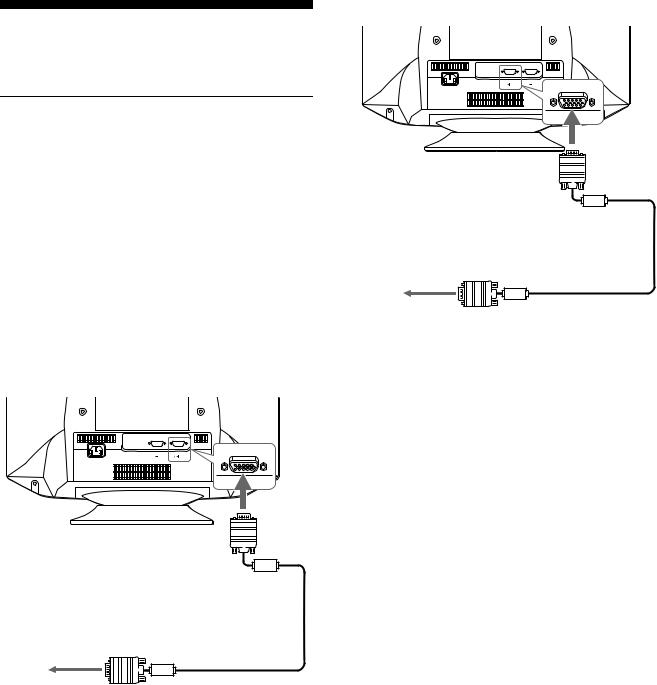
Installation et configuration
Ce moniteur fonctionne avec des systèmes dont la fréquence horizontale est comprise entre 30 et 130 kHz.
Etape 1:Raccordez votre moniteur à votre ordinateur
Mettez le moniteur et l’ordinateur hors tension avant de procéder au raccordement.
Raccordez l’extrémité appropriée du câble de signal vidéo à la sortie vidéo de votre ordinateur.
Raccordez l’autre extrémité du câble de signal vidéo à l’entrée appropriée du moniteur.
Remarques
•Ne touchez pas les broches du connecteur du câble de signal vidéo. Vous risquez en effet de les plier et de les rendre inutilisables.
•Lors du raccordement du câble de signal vidéo, vérifiez l’alignement du connecteur HD15. N’essayez pas d’insérer le connecteur dans le mauvais sens. Vous risquez en effet de plier les broches et de les rendre inutilisables.
x Raccordement à un premier ordinateur
x Raccordement à un second ordinateur
2 1
AC IN
vers HD15
vers la sortie vidéo de l’ordinateur
câble de signal vidéo
2 |
1 |
AC IN
vers HD15
vers la sortie vidéo de l’ordinateur
câble de signal vidéo
6
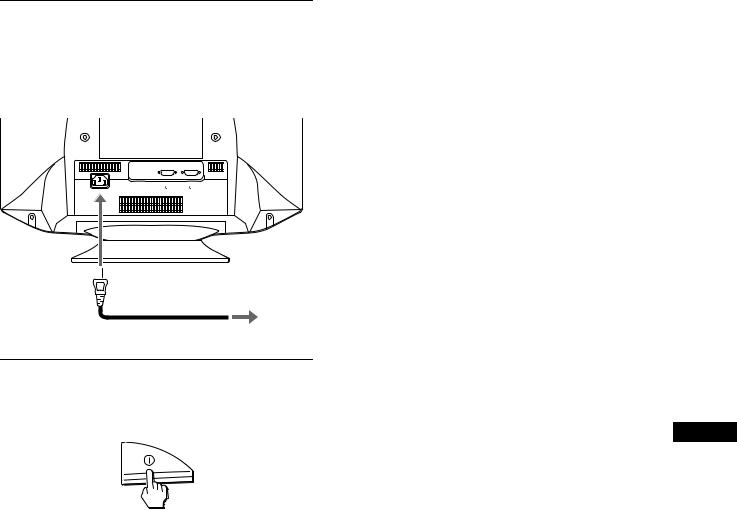
Etape 2:Raccordez le cordon d’alimentation secteur
Après avoir mis l’appareil et l’ordinateur hors tension, connectez d’abord le cordon d’alimentation à l’ordinateur, puis à une prise électrique.
2 |
1 |
AC IN
vers AC IN 
vers une prise électrique
cordon d’alimentation (fourni)
Si aucune image n’apparaît à l’écran
•Assurez-vous que le moniteur est raccordé correctement à l’ordinateur.
•Si l’indication PAS DE VIDEO apparaît à l’écran, essayez de modifier le signal d’entrée (page 8), et assurez-vous que votre carte graphique est correctement et totalement insérée dans le connecteur de bus adéquat.
•Si vous remplacez un ancien moniteur par ce modèle et que l’indication HORS PLAGE DE BALAYAGE apparaît à l’écran, rebranchez l’ancien moniteur. Ajustez ensuite la carte graphique de l’ordinateur de sorte que la fréquence horizontale soit comprise entre 30 et 130 kHz et que la fréquence verticale soit comprise entre 48 et 170 Hz.
Pour obtenir plus d’informations sur les indications apparaissant à l’écran, reportez-vous à la section “Symptômes et remèdes”, page 19.
Etape 3:Mettez le moniteur et l’ordinateur sous tension
Mettez d’abord le moniteur sous tension, puis l’ordinateur.
FR
L’installation du moniteur est terminée.
Si nécessaire, utilisez les commandes du moniteur pour régler l’image.
7
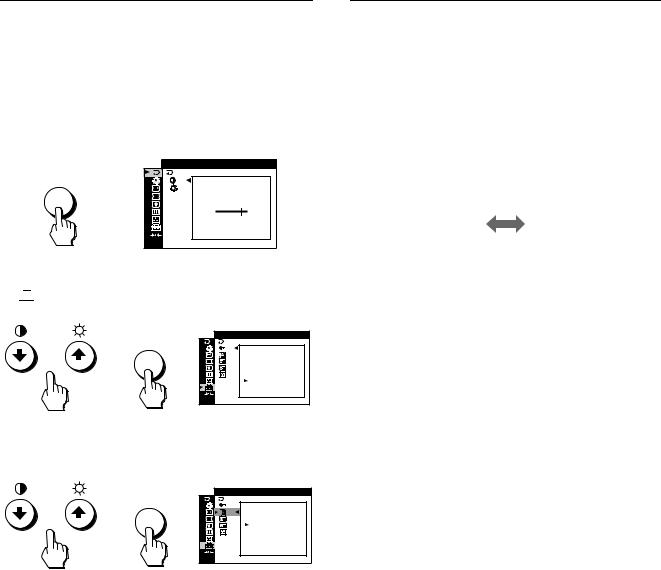
Sélection de la langue d’affichage à l’écran (LANGUAGE)
Les menus peuvent être affichés en anglais, français, allemand, espagnol, italien, néerlandais, suédois, russe et japonais. La langue par défaut est l’anglais.
1 Appuyez sur la touche MENU/OK.
Le menu apparaît à l’écran. |
|
|
MENU |
|
EX I T |
|
|
|
OK |
|
CONTRAST |
b |
|
|
|
85 |
|
|
|
|
|
|
1 6 0 0 x 1 2 0 0 / 8 5 H z |
2Appuyez sur les touches m/M pour mettre



 OPTION en surbrillance, puis appuyez sur la touche MENU/OK.
OPTION en surbrillance, puis appuyez sur la touche MENU/OK.
MENU |
|
OPT I ON |
|
|
|
b OK |
b |
CONTROL |
LOCK |
||
ON |
||
|
|
OFF |
|
|
1 6 0 0 x 1 2 0 0 / 8 5 H z |
3Appuyez sur les touches m/M pour mettre

 LANGUAGE en surbrillance, puis appuyez sur la touche MENU/OK.
LANGUAGE en surbrillance, puis appuyez sur la touche MENU/OK.
|
MENU |
|
OPT I ON |
|
|
|
|
b |
OK |
b |
LANGUAGE |
ENGL I SH |
|||
|
FRANÇA I S |
||
|
|
|
DEUTSCH |
|
|
|
1 / 3 |
|
|
|
1 6 0 0 x 1 2 0 0 / 8 5 H z |
4Appuyez sur les touches m/M jusqu’à ce que la langue d’utilisation souhaitée s’affiche à l’écran. Appuyez ensuite sur la touche MENU/OK pour sélectionner cette langue.
Chaque fois que vous appuyez sur les touches m/M, les langues apparaissent dans l’ordre suivant :
•ENGLISH : Anglais
•FRANÇAIS
•DEUTSCH : Allemand
•ESPAÑOL : Espagnol
•ITALIANO : Italien
•NEDERLANDS : Néerlandais
•SVENSKA : Suédois
•


 : Russe
: Russe
•
 : Japonais
: Japonais
Pour fermer le menu
Appuyez sur les touches m/M pour sélectionner . Si vous n’appuyez sur aucune touche, le menu est automatiquement fermé au bout de 30 secondes environ.
. Si vous n’appuyez sur aucune touche, le menu est automatiquement fermé au bout de 30 secondes environ.
Pour revenir à l’anglais
Sélectionnez ENGLISH à l’étape 4 ci-dessus.
Sélection du signal d’entrée
Les connecteurs HD15 vous permettent de raccorder deux ordinateurs à ce moniteur. Pour basculer d’un ordinateur à l’autre, utilisez le commutateur INPUT.
Déplacez le commutateur INPUT.
L’indication du connecteur sélectionné apparaît sur l’écran du moniteur pendant 3 secondes.
INPUT
1  2
2
L’indication “INPUT 1” ou “INPUT 2” apparaît.
Remarque
Si aucun signal n’est entré par le connecteur sélectionné, le message PAS DE VIDEO apparaît à l’écran. Après quelques secondes, le moniteur passe en mode d’économie d’énergie. Si tel est le cas, basculez sur l’autre connecteur.
8
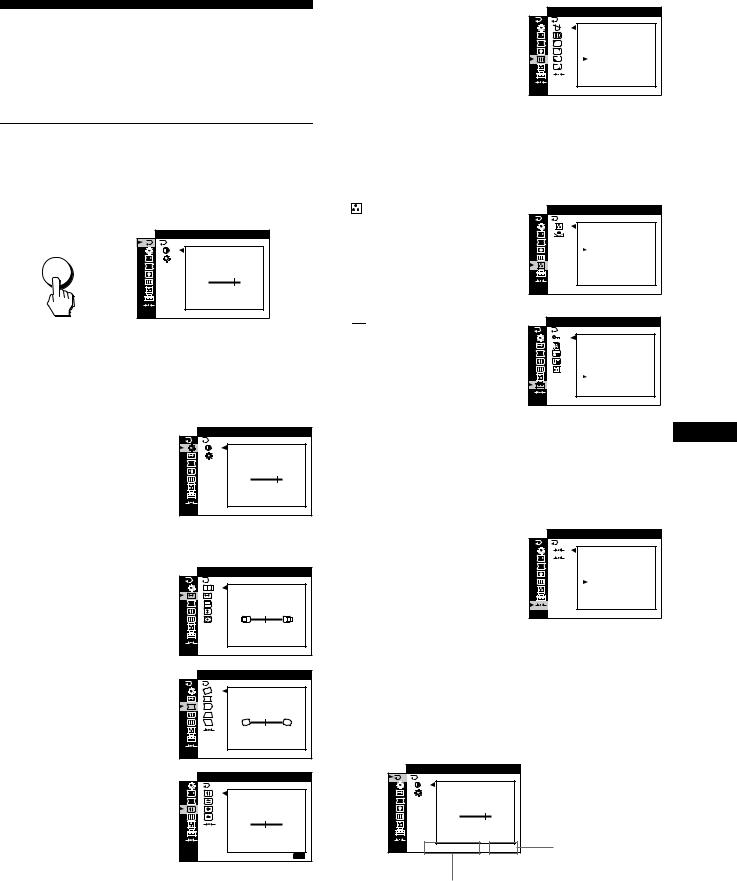
Personnalisation de votre moniteur
Les menus à l’écran vous permettent d’apporter un grand nombre d’ajustements à votre moniteur
Navigation dans le menu
Appuyez sur la touche MENU/OK pour afficher le menu à l’écran. Reportez-vous à la page 10 pour plus d’informations sur l’utilisation des touches MENU/OK, m/M et –/+.
MENU |
SORT I R |
|
|
|
CONTRASTE |
OK |
b |
|
85 |
|
1 6 0 0 x 1 2 0 0 / 8 5 H z |
Appuyez sur les touches m/M pour sélectionner l’un des menus suivants.
 SORTIR
SORTIR
Permet de refermer le menu.
 CONTR/LUMIN (page 10)
CONTR/LUMIN (page 10)
Ajuste le contraste et la luminosité de l’image. Vous pouvez également afficher directement ce menu en appuyant sur les touches 6/ m ou  /M alors qu’aucun menu n’est affiché à l’écran.
/M alors qu’aucun menu n’est affiché à l’écran.
 TAILLE/CENTRAGE (page 11)
TAILLE/CENTRAGE (page 11)
Permet d’ajuster la taille ou le centrage.
 GEOMETRIE (page 12)
GEOMETRIE (page 12)
Permet d’ajuster la rotation et la forme de l’image.
 CONVERGENCE (page 12)
CONVERGENCE (page 12)
Permet d’ajuster la convergence horizontale ou verticale de l’image.
CONTR / LUM I N |
CONTRASTE |
85 |
1 6 0 0 x 1 2 0 0 / 8 5 H z |
TA I LLE / CENTRAGE
45 |
1 6 0 0 x 1 2 0 0 / 8 5 H z |
GEOMETR I E |
45 |
1 6 0 0 x 1 2 0 0 / 8 5 H z |
CONVERGENCE |
T |
B |
45 |
SORT I R : MENU |
 ECRAN (page 13)
ECRAN (page 13)
Permet d’ajuster la qualité de l’image.
Les options comprennent :
•la démagnétisation de l’écran (DEMAGNET)
•l’ajustement de l’annulation de l’effet de moiré (SUPPRESSION MOIRAGE)
•l’ajustement de l’alignement (PURETE COULEUR)
ECRAN |
DEMAGNET |
OK |
ANNULER |
1 6 0 0 x 1 2 0 0 / 8 5 H z |
COULEUR (page 14)
Permet d’ajuster la température des couleurs de l’image afin de faire correspondre les couleurs du moniteur avec celles imprimées.
 OPTION (page 16)
OPTION (page 16)
Permet d’ajuster les options du moniteur.
Les options comprennent :
•verrouillage des commandes
•sélection de la langue d’affichage à l’écran
•modification de la position des menus à l’écran
•modification du mode de réglage de la température des couleurs de l’image
COULEUR : PRESELECT
9 3 0 0 K |
6 5 0 0 K |
5 0 0 0 K |
1 6 0 0 x 1 2 0 0 / 8 5 H z |
OPT I ON
VERROU |
MENU |
ACT I F |
I NACT I F |
1 6 0 0 x 1 2 0 0 / 8 5 H z |
FR
0 REINITIALISATION |
RE I N I T I AL I SAT I ON |
|
(page 16) |
1 |
|
Restaure les réglages á leur |
2 |
LE MODE |
valeur par dèfaut. |
|
ACTUEL |
|
OK |
|
|
|
|
|
|
ANNULER |
|
1 6 0 0 x 1 2 0 0 / 8 5 H z |
|
x Affichage du signal d’entrée actuel
Lorsque vous appuyez sur la touche MENU/OK pour afficher le menu, les fréquences horizontale et verticale du signal d’entrée actuel sont affichées dans le menu. Si le signal correspond à celui de l’un des modes par dèfaut (Appendix), la résolution correspondante est également affichée. Si le signal d’entrée actuel ne correspond à aucun des réglages par défaut, les fréquences verticale et horizontale s’affichent.
SORT I R |
|
|
CONTRASTE |
|
|
85 |
|
|
1 6 0 0 x 1 2 0 0 / |
8 5 H z |
fréquences |
|
|
verticales du |
|
|
signal d’entrée |
|
|
actuel |
fréquences horizontales/ résolution du signal d’entrée actuel
(suite page suivante)
9

xUtilisation des touches MENU/OK, m/M et
–/+
1Affichez le menu.
Appuyez sur la touche MENU/OK pour afficher le menu à l’écran.
MENU
OK
2Sélectionnez le menu que vous souhaitez régler.
Mettez le menu souhaité en surbrillance en appuyant sur les touches m/M. Appuyez ensuite sur la touche MENU/OK.
MENU b OK
3Apportez les ajustements nécessaires.
Appuyez sur les touches –/+ pour effectuer le réglage, puis appuyez sur la touche MENU/OK.
Si vous souhaitez sélectionner un autre menu :
Appuyez sur les touches m/M pour sélectionner  , puis appuyez sur la touche MENU/OK pour quitter le menu.
, puis appuyez sur la touche MENU/OK pour quitter le menu.
MENU
b OK
4Refermez le menu
Chaque fois que vous sélectionnez  et la touche MENU/ OK, le menu se ferme. Si vous n’appuyez sur aucune touche, le menu est fermé automatiquement après 30 secondes environ.
et la touche MENU/ OK, le menu se ferme. Si vous n’appuyez sur aucune touche, le menu est fermé automatiquement après 30 secondes environ.
MENU
OK
Réglage de la luminosité et du contraste (CONTR/LUMIN)
Ces réglages sont conservés en mémoire pour les signaux reçus du connecteur d’entrée actuellement sélectionné.
1Appuyez sur la touche 6 (contraste) /m ou  (luminosité) /M.
(luminosité) /M.
Le menu CONTR/LUMIN apparaît à l’écran.
2Appuyez sur les touches –/+ pour régler le contraste (6) ou la luminosité ( ).
).
Si vous utilisez le mode sRGB
Si vous avez sélectionné le mode sRGB dans l’option
MODE COULEUR (
 ) dans le menu OPTION (
) dans le menu OPTION (


 ), le menu CONTR/LUMIN suivant apparaît à l’écran.
), le menu CONTR/LUMIN suivant apparaît à l’écran.
CONTR / LUM I N |
|
s RGB |
|
: |
/ |
1 6 0 0 x 1 2 0 0 / 8 5 H z |
|
Vous ne pouvez régler le contraste (6) ou la luminosité ( ) dans cet écran. Si vous voulez les régler, sélectionnez un mode autre que sRGB dans l’option MODE COULEUR (
) dans cet écran. Si vous voulez les régler, sélectionnez un mode autre que sRGB dans l’option MODE COULEUR (
 ) du menu OPTION (
) du menu OPTION (


 ).
).
Pour obtenir plus d’informations sur l’utilisation du mode sRGB, voir “Réglage de la couleur de l’image (COULEUR)” à la
page 14.
10
